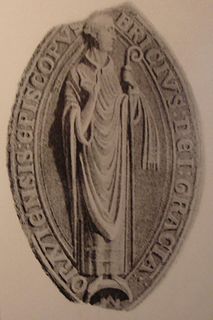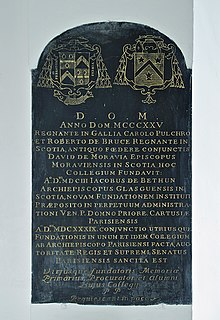William de Sancto Claro, or simply William Sinclair, was a 14th-century bishop of Dunkeld. He was the son of Amicia de Roskelyn and Sir William Sinclair, Baron of Roslin. He was the brother of Sir Henry Sinclair, baron of Roslin. After the death of Bishop Matthew de Crambeth in 1309, William was elected to the bishopric. The following year, on 24 February 1310, William was one of twelve Scottish bishops to swear fealty to King Robert the Brus. However, king Edward II of England had his own candidate in mind, John de Leck. William went to the Holy See, where his election was contested by the said John. The diocese of Dunkeld lay vacant for three years. Pope Clement V appointed Cardinal James, cardinal deacon of St George in Velabro, to judge the issue. However, the issue was more or less resolved when, on 22 May 1311, John de Leck was promoted to the Archbishopric of Dublin. When John de Leck took over the see of Dublin on 20 July, he retired from the dispute. The pope then declared William's election canonical, and sent him to Cardinal Berengar Fredol, bishop of Tusculum, in order to be consecrated. On 3 February 1313 king Edward II issued a safe-conduct to William, clearly indicating that the bishop was planning to arrive in England on his way back to Scotland, however Edward demanded cooperation in political matters as a condition. William became a frequent witness to King Robert's charters, but that did not prevent Bishop William, on 24 September 1332, being present at the coronation of Edward Balliol. Bishop William attended the latter's parliaments. William died on 27 June 1337, and was buried in the choir of Dunkeld Cathedral.
John Scotus was a 12th-century Bishop of St. Andrews and Dunkeld.
Hugh the Chaplain was the royal Chaplain of King William I of Scotland before becoming Bishop of Cell Rígmonaid (St Andrews), the highest ranking Scottish see of the period. After the death of Bishop Richard, King William selected Hugh to succeed to the bishopric in 1178. However, unbeknown to the king, the chapter elected their archdeacon, John l'Escot, as bishop. The king saw to Hugh's election and consecration in the same year. There followed a five-year struggle for the bishopric. John travelled to appeal to Pope Alexander III, who quashed the case of Hugh and sent to Scotland a man named Alexius as legate. Alexius obtained entrance to William's kingdom, and consecrated John at Holyrood Abbey in the presence of four other Scottish bishops, in the year 1180. Nevertheless, the struggle continued, and in 1183, both John and Hugh resigned their rights. Despite the fact that Hugh received the bishopric and John took the Bishopric of Dunkeld in compensation, dispute over revenues continued. When Hugh refused to answer his summons to Rome in 1186, he was suspended and excommunicated, with the diocese being put under interdict. Hugh travelled to Rome and obtained absolution, but he died of the pestilence in that city a few days later.
Robert de Stuteville was Bishop-elect of St Andrews and Bishop of Dunkeld. Robert was dean of Dunkeld as early as 1253, when he was elected to the bishopric of St Andrews on 28 June that year. His election was opposed by the king, Alexander III, and by the bishopric's Céli Dé chapter. The prior and the canons sent Robert to Rome, but a delegation of the king, including Abel de Golynn, was also sent, and the result was that Robert's election was quashed.
James Bane was Bishop of St. Andrews for a brief period in the early 14th century. In his earlier career, James had been a canon of Aberdeen and prebendary of Cruden.

Bricius was prior of Lesmahagow and afterward bishop of Moray.

Andreas de Moravia was a 13th-century Scottish bishop. He was a younger son of Hugh de Moravia, from the family of Flemish origin who were lords of Duffus and other areas in the Greater Moray region in this period. In the time of Bishop Bricius' episcopate (1203–1222), there was a man called "Andreas" who was rector of the church of St. Peter at Duffus, and this may well have been this Andreas. He may also have been a native Scot.
Robert Blackadder was a medieval Scottish cleric, diplomat and politician, who was abbot of Melrose, bishop-elect of Aberdeen and bishop of Glasgow; when the last was elevated to archiepiscopal status in 1492, he became the first ever archbishop of Glasgow. Archbishop Robert Blackadder died on 28 July 1508, while en route to Jerusalem on pilgrimage.
Richard de Prebenda was an early 13th-century bishop of Dunkeld. He had previously been a clerk of King William of Scotland and was appointed to the bishopric in 1203. Records indicate a commission of Pope Innocent III attempting to resolve a dispute between Richard and the prior of St Andrews regarding control of the church of Meigle. He died in May 1210, at Cramond in Midlothian, and was buried on the island of Inchcolm.
Robert Sinclair was a late 14th century bishop of Orkney and bishop of Dunkeld.
John Luce was a 14th-century bishop of Dunkeld. He had been a precentor of Dunkeld before being appointed to the bishopric by Pope Innocent VI on 18 May 1355. John had been elected to the bishopric some months before by the diocese's chapter, but the pope had reserved the see for himself. Thus the pope declared the election null and void, but still appointed John. Soon afterwards John was consecrated by Cardinal Peter de Pratis, bishop of Palestrina. John's episcopate is rather unnotable, and most of his legacy consists of a few charters. He was a witness to the 14-year truce signed between Scotland and England on 20 July 1369.
Donnchadh de Strathearn was a 14th-century bishop of Dunkeld. He was probably from the family of the Gaelic Earls of Strathearn, perhaps even the son of Maol Íosa IV, Earl of Strathearn. He was in the company of, as his brother Maol Íosa V was, Edward Balliol when the latter invaded Scotland and contested the crown of the young king David Bruce. Following the death of William Sinclair, bishop of Dunkeld, Pope Clement VI, who had previously reserved the see for his own nominee, appointed Donnchadh as bishop. This was in the year 1347. The canons of Dunkeld had actually elected another man, Robert de Den, as bishop, but this election was quashed. Donnchadh does not seem to have experienced many problems with King David after the latter's restoration. He attended David's parliaments and frequently attested his charters.
Maol Choluim de Innerpeffray was a 14th-century bishop-elect of Dunkeld. He was a canon from Strathearn. After the death of bishop William Sinclair, the canons of Dunkeld held an election, which was held late in the year 1337 or early 1338. The result was disputed. Maol Choluim's election was challenged by Richard de Pilmor.
George Crichton or Crichtoun served as Abbot of Holyrood Abbey then as the Bishop of Dunkeld until his death on 24 January 1543.

Archibald was a Scottish prelate best known for involvement in a dispute with the Pope.

David de Moravia was Bishop of Moray during most of the First War of Scottish Independence. He was elected Bishop of Moray, probably in early 1299. Extended details exist regarding the election because of an extant letter of Pope Boniface VIII. The result of the election was that David had 13 votes, the Dean had 4 votes, the Chancellor had 3 votes and the Archdeacon 1 vote. The Dean declared that David was elected, and sent a request for confirmation to the Papacy. The latter found an irregularity, though what exactly this was not revealed. The election result was nominally declared void, but the Pope himself provided David directly to the bishopric. He was consecrated as bishop at Anagni in Italy on 28 June 1299, by Matthew of Aquasparta, Cardinal-Bishop of Porto.
John de Pilmuir [Pilmor, Pylmore] was a 14th-century prelate based in Scotland. He was probably the son of Adam de Pilmuir, a Dundee burgess, and the brother of Richard de Pilmuir, Bishop of Dunkeld (1337/38–1345/47).

Alexander Bur was a 14th-century Scottish cleric. It is highly possible that Bur came from somewhere in or around Aberdeenshire, although that is not certain and is only based on the knowledge that Aberdeenshire is where other people bearing his surname come from in this period. He entered the service of King David II of Scotland sometime after 1343, perhaps as a member of David's exiled court at Château Gaillard. Although Alexander by this point in time already held prebends in both the bishopric of Aberdeen and the bishopric of Dunkeld, on that date King David petitioned Pope Clement VI for another canonry in the bishopric of Moray. Alexander had become a royal clerk and had obtained a Licentiate in Canon Law by 1350. By the latter date, upon the death of Adam Penny, Archdeacon of Moray, Alexander himself became Archdeacon.
Ingram de Ketenis [de Kethenys] was a medieval cleric from Angus in Scotland.

Albin was a 13th-century prelate of the Kingdom of Scotland. A university graduate, Albin is known for his ecclesiastical career in the diocese of Brechin, centred on Angus in east-central Scotland.



